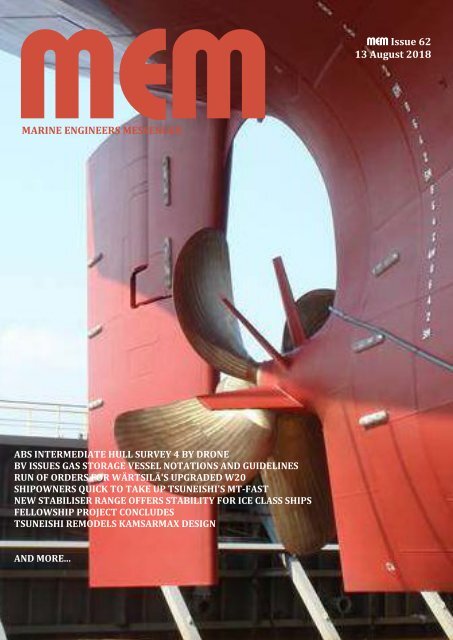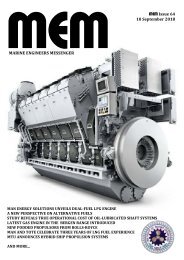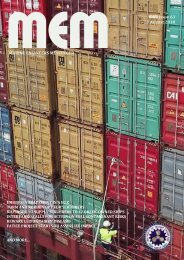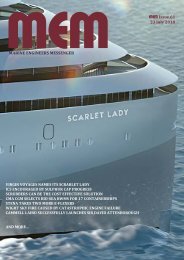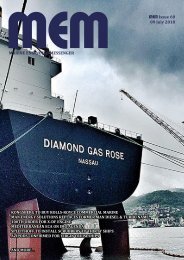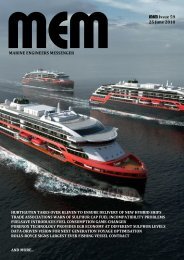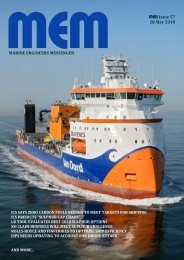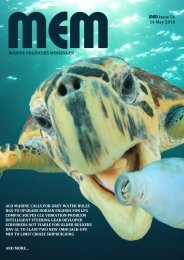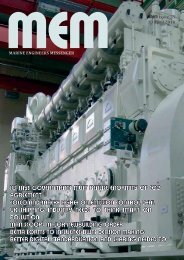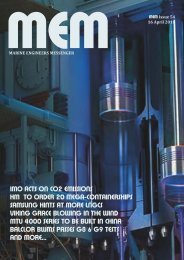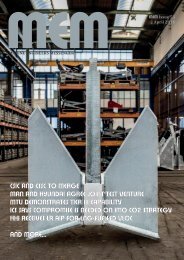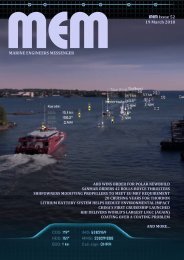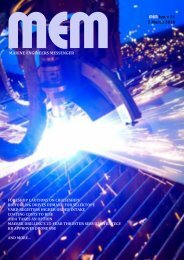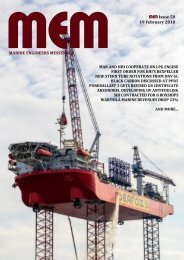You also want an ePaper? Increase the reach of your titles
YUMPU automatically turns print PDFs into web optimized ePapers that Google loves.
MEM<br />
MEM Issue 62<br />
13 August 2018<br />
MARINE ENGINEERS MESSENGER<br />
ABS INTERMEDIATE HULL SURVEY 4 BY DRONE<br />
BV ISSUES GAS STORAGE VESSEL NOTATIONS AND GUIDELINES<br />
RUN OF ORDERS FOR WÄRTSILÄ'S UPGRADED W20<br />
SHIPOWNERS QUICK TO TAKE UP TSUNEISHI'S MT-FAST<br />
NEW STABILISER RANGE OFFERS STABILITY FOR ICE CLASS SHIPS<br />
FELLOWSHIP PROJECT CONCLUDES<br />
TSUNEISHI REMODELS KAMSARMAX DESIGN<br />
AND MORE...
MEM<br />
MARINE ENGINEERS MESSENGER<br />
Telegraph<br />
T<br />
hat cyber hackers successfully attacked COSCO Shipping Line’s Long<br />
Beach customer service centre, is very worrying indeed, said Naval<br />
Dome’s CEO Itai Sela, after the news broke.<br />
"While COSCO shut down its connections as a precautionary<br />
measure, we have to emphasise that ships are not islands, they are not<br />
self-contained units. This is a mistaken belief. Shore- and shipoperations<br />
are cyber-connected.<br />
"If shore-based and ship-based IT systems are linked, it could open a<br />
gateway to the COSCO ships, leaving them highly susceptible to an<br />
attack. Vessels do not need to be attacked directly but an attack can<br />
arrive via the company’s shore-based IT systems and very easily<br />
penetrate the ships’ critical OT systems.<br />
"Although COSCO has been quick to respond to this hack, the virus<br />
may have been dormant for some time, so I would not be surprised if<br />
other systems – shore- and ship-based systems – have been breached.<br />
"This kind of attack could spread through the entire fleet and its<br />
consequences might be devastating, and certainly costly, especially in<br />
terms of insurance. We strongly recommend to whoever discovered the<br />
attack, to thoroughly verify the breach has been contained and has not<br />
infected any ships in the COSCO fleet.<br />
Certainly, if one computer is affected by an attack it is possible to<br />
disconnect from the network. But on a vessel, where OT systems are<br />
being used to operate the vessel, disconnecting the equipment is not an<br />
option. For example, if a virus is detected which relates to the engine,<br />
stopping it during the approach to a port is not possible, even if a degree<br />
of redundancy is incorporated in ships’ systems.<br />
The differing demands of IT and OT systems need to be reflected in<br />
the regulations, and this is not currently the case and regulators need to<br />
implement workable rules and guidelines to help this vitally important<br />
global industry defend itself properly,” said Sela,<br />
"This cyber-attack, like the Maersk attacks last year, will no doubt<br />
send shockwaves throughout the industry and encourage board<br />
members to take immediate, effective protection.<br />
MEM Issue 62<br />
13 August 2018<br />
MEM Contacts:<br />
Editorial:<br />
Bill Thomson<br />
editorial@mem-online.com<br />
+44 (0) 208 339 6185<br />
+44 (0)777 7668 928<br />
Advertising/Subscriptions:<br />
advertising@mem-online.com<br />
+44 (0) 208 339 6183<br />
Publisher:<br />
publisher@mem-online.com<br />
Website:<br />
www.mem-online.com<br />
The information published in MEM does<br />
not necessarily represent the views of<br />
the publisher. The publisher makes no<br />
representation or warranty as to the<br />
accuracy or correctness of the<br />
information or accepts responsibility<br />
for any loss, damage or other liability<br />
pertaining to the information published<br />
in this newsletter.<br />
©2018 Seaborne Communications Ltd<br />
3
REGULATIONS & GUIDANCE<br />
ABS INTERMEDIATE HULL SURVEY 4 BY DRONE<br />
Cyberhawk, a ship<br />
inspection and survey<br />
company, has<br />
successfully<br />
completed the first<br />
full ABS Intermediate<br />
Hull Survey 4 on an<br />
oil tanker using a<br />
unmanned aerial<br />
vehicle (UAV),<br />
otherwise called a<br />
drone.<br />
The company<br />
performed full class<br />
inspection across 19<br />
tanks onboard an oil<br />
tanker while at a<br />
shipyard in<br />
Singapore. This<br />
included 12 Cargo Oil<br />
Tanks (COT), two slop tanks and<br />
five ballast tanks. Attending was<br />
the American Bureau for Shipping<br />
(ABS) to ensure the quality of the<br />
inspection complied with the<br />
specific ABS rules (ESP) set for<br />
tankers. The inspection also had to<br />
satisfy the US Coast Guard’s<br />
Critical Area Inspection Plan<br />
(CAIP) as the vessel was American<br />
flagged and operated in Alaskan<br />
waters.<br />
The traditional method of<br />
inspection for this type of tanker<br />
would be to scaffold the inside of<br />
the tank and have ABS surveyors<br />
perform a visual survey and NDT<br />
technicians take thickness<br />
measurements.<br />
Malcolm Connolly, Technical<br />
Director at Cyberhawk, said:<br />
“Since we conducted the first UAV<br />
tank inspection back in 2015, the<br />
take up of this solution has<br />
become increasingly adopted<br />
within the industry.<br />
“These previous inspections,<br />
however, have only focused on<br />
capturing visual data of<br />
approximately 20 to 30 critical<br />
areas. To comply with ABS rules<br />
for this particular category of class<br />
survey, we required close up<br />
coverage of 100% of the tank’s<br />
internal frame structure at a<br />
resolution equivalent to a person<br />
viewing the surface at arm’s<br />
length.”<br />
The Cyberhawk team<br />
completed more than 350 flights<br />
and collected over 600GB of data.<br />
The data is being hosted in<br />
iHawk, Cyberhawk’s cloud-based<br />
visual asset management<br />
software, which has been<br />
designed to host the huge<br />
volumes of data captured by<br />
UAVs or other sources and allow<br />
the user to access this data in a<br />
functional and intuitive way.<br />
iHawk provides a 360-degree<br />
view of the inside of the tanks,<br />
with defects and areas of interest<br />
highlighted. It also provides a<br />
complete visual record of the<br />
tank, which can be referred to on<br />
an ongoing basis to monitor the<br />
condition of the tank and the<br />
degradation of any defects.<br />
Chris Fleming, CEO at<br />
Cyberhawk added: “UAVs and<br />
robotics in general have taken<br />
inspection to a new level thanks<br />
to the time, cost and safety<br />
benefits being proven every day.<br />
However, digitising the data<br />
captured is a transformational<br />
step for the asset management<br />
industry.<br />
“The days of PDF and paper<br />
reports are numbered, where<br />
reporting by exception and<br />
capturing data only on areas of<br />
concern is the standard.<br />
Technology advances, which<br />
allow digital data to be captured<br />
consistently on 100% of a<br />
structure, open the door for<br />
effective risk-based inspection<br />
(RBI) programmes. Generating<br />
these huge volumes of data,<br />
however, creates its own<br />
challenges and requires a<br />
different approach to reporting in<br />
order to get the best value out of<br />
the data.<br />
“By hosting data in a cloudbased<br />
asset management system,<br />
such as iHawk, inspection<br />
information can be viewed in a<br />
far more intuitive and efficient<br />
way compared with wading<br />
through a 100-page inspection<br />
document. This also means that<br />
multiple stakeholders can access<br />
and view exactly the same data,<br />
which also provides a realistic<br />
representation of the asset even<br />
for those who have never been in<br />
contact with it.<br />
“Cyberhawk continues to push<br />
the boundaries of the inspection<br />
industry, not only in terms of<br />
access and data capture, but also<br />
in how that data is presented and<br />
used. This project marks another<br />
major accomplishment within<br />
this field.”<br />
4
LIBERIA INTRODUCES DIGITAL CERTIFICATE SECURITY<br />
The Liberian Register is continuing<br />
to improve its web-based client<br />
interface system, WayPoint, by<br />
enhancing certificate security<br />
features, introducing a QR Code<br />
symbol for electronic certificates<br />
and streamlining the procedure for<br />
document verification.<br />
WayPoint was launched in late-<br />
2016 to provide the owners and<br />
operators of Liberian-flag ships<br />
with secure, real-time, userfriendly<br />
access to their fleet<br />
details, as well as to facilitate<br />
International Convention<br />
certification applications. It was<br />
upgraded last year to include a<br />
number of major improvements<br />
designed to help owners and<br />
operators to manage their fleetwide<br />
regulatory compliance issues<br />
more efficiently.<br />
Beginning 7 August, Liberia will<br />
start including QR Codes to<br />
enhance the document verification<br />
process. This means that Port State<br />
Control and other interested<br />
parties can quickly scan the QR<br />
matrix barcode via their mobile<br />
phones, whereafter they will be<br />
directed to the verification page.<br />
The QR code and the Registry’s<br />
tracking identification (TID)<br />
number will also be clickable if<br />
viewed on a computer and will<br />
direct users to the verification<br />
page, where a verification copy of<br />
the document can be viewed and<br />
downloaded. In addition to these<br />
public-facing features, a variety of<br />
embedded security features are<br />
also being deployed to enhance the<br />
electronic integrity of Liberia’s<br />
electronic certificates.<br />
Scott Bergeron (pictured), CEO<br />
of the Liberian International Ship<br />
& Corporate Registry (LISCR), the<br />
US-based manager of the Liberian<br />
Registry, says, “Liberia was the<br />
first flag state to make widespread<br />
use of electronic certificates in<br />
2009. We are very happy to see<br />
other flags and recognized<br />
organizations follow our lead with<br />
their own electronic certifications.<br />
As technology evolves, so does the<br />
need to ensure that security and<br />
verification features are robust<br />
enough to meet cyber challenges.<br />
With this latest update, Liberia has<br />
further strengthened its<br />
reputation as the world’s most<br />
technologically advanced and<br />
sophisticated ship register, taking<br />
the pain and expense of document<br />
verification away from owners and<br />
operators and freeing up their<br />
time to concentrate on making<br />
their vessels safer and more<br />
profitable.”<br />
BV ISSUES GAS STORAGE VESSEL NOTATIONS AND GUIDELINES<br />
Bureau Veritas (BV) has issued new and updated<br />
notations and guidance to support the construction<br />
and operation of both Floating Storage and<br />
Regasification Units (FSRUs) and Floating Storage<br />
Units (FSUs).<br />
According to BV, interest in FSRUs and FSUs is<br />
growing. Floating gas terminals offer operational<br />
flexibility, reduced timescales - from concept to<br />
operation, and cost effectiveness in comparison with<br />
onshore terminals.<br />
Additionally, converting existing LNG carriers<br />
offers a fast route to operational<br />
availability. There are more than<br />
20 LNG carriers presently in laidup<br />
condition. Many of them are<br />
candidates for conversion to<br />
floating terminal applications, such<br />
as FSRU or FSU operations. The<br />
new conversion guidelines provide<br />
clear advice to the LNG industry in<br />
properly addressing issues that<br />
either will or may arise during the<br />
conversion of LNG carriers into<br />
FSRUs or FSUs, helping shipowners<br />
to either avoid or to overcome<br />
potential problems.<br />
Matthieu de Tugny, COO, BV Marine & Offshore<br />
(pictured) said, “With growing interest in floating<br />
gas terminals, working with industry stakeholders,<br />
we are providing the rule framework and guidance<br />
necessary to develop both FSRU and FSU terminals<br />
– both for newbuildings and conversions.<br />
“Last November, Bureau Veritas published<br />
NR645, the first rules document fully dedicated to<br />
Floating Storage and Regasification Units. These<br />
new notations and guidelines are further evidence<br />
of BV’s classification leadership in both FSRUs and<br />
FSUs.”<br />
Bureau Veritas adds that the first<br />
FSRU newbuild, delivered in 2005,<br />
was to BV class; the largest FSRU<br />
ever built is MOL’s BV classed<br />
263,000 m3 unit delivered in 2017;<br />
nearly 40% of the fleet in service is<br />
BV class.<br />
Additionally, a broad range of<br />
second-party services is provided by<br />
Bureau Veritas including: risk<br />
assessment and support including<br />
tools for sloshing analysis, mooring,<br />
CFD, hydro-structural assessments<br />
and ice/structure interaction.<br />
5
PRIME MOVERS<br />
RUN OF ORDERS FOR WÄRTSILÄ'S UPGRADED W20<br />
Wärtsilä has reported a run of orders for its upgraded<br />
Wärtsilä 20 engine, with a total of 33 engines<br />
specified for various newbuild projects. The<br />
orders, placed in June, have been contracted with<br />
Wärtsilä Qiyao Diesel Company (WQDC), the<br />
joint venture company between Wärtsilä and<br />
Shanghai Marine Diesel Engine Research<br />
Institute (SMDERI).<br />
The engines will be installed in 11 new<br />
vessels being built in shipyards owned by China<br />
Shipbuilding Industry Corporation (CSIC). The<br />
ships have been ordered by China COSCO<br />
Shipping and COSCO Shipping Bulk.<br />
In each case, the increased power output of the new<br />
Wärtsilä 20 engine and fuel flexibility were cited as<br />
major factors in the purchasing decision. On a power to<br />
weight ratio, the upgraded Wärtsilä 20 is rated as best in<br />
its class. Furthermore, the engine design allows for<br />
conversion to dual-fuel operation. The opportunity for<br />
conversion at a later stage is seen as an attractive option<br />
for owners and operators when preparing for upcoming<br />
emissions legislation, most notably the global 0.50%<br />
sulphur restrictions entering into force in 2020.<br />
“These orders emphasise the value that the Wärtsilä<br />
20 engine now adds to customer operations. Its highpower<br />
output, efficiency, and flexibility deliver true<br />
benefits that are of critical importance in lowering<br />
operating costs and meeting environmental legislation.<br />
“We are pleased to again be working with China<br />
COSCO Shipping, a company with whom we have<br />
enjoyed a long relationship. We also congratulate our<br />
colleagues at WQDC and SMDERI for their hard work in<br />
successfully negotiating these contracts,” said Janne<br />
Klemola, Product Director, Wärtsilä Marine Solutions.<br />
Mr. Wang Minghao from COSCO Shipping Bulk, added:<br />
“Owners are today more than ever seeking the best value<br />
for their investment and flexibility. We are convinced<br />
that for these auxiliary applications, the new Wärtsilä 20<br />
engine provides this. Wärtsilä’s excellent support, both<br />
local and global,<br />
is also much appreciated.”<br />
The contracts cover three engines for four Very<br />
Large Crude Carriers (VLCC) being built at CSIC’s Dalian<br />
Shipbuilding Industry Corporation (DSIC) shipyard for<br />
China COSCO Shipping Energy; three engines for each of<br />
three Suezmax Oil Tankers being built at DSIC for China<br />
COSCO Shipping Energy; and three engines for each of<br />
four Large Ore Carriers (VLOC) being built at CSIC’s<br />
Tianjin Xingang shipyard for COSCO Shipping Bulk. The<br />
Wärtsilä scope includes complete auxiliary generating<br />
sets and all related engineering. Delivery of the<br />
equipment will begin in 2019.<br />
The upgraded Wärtsilä 20 engine was launched to<br />
the market in December 2017 as a more powerful<br />
version of the well-established and robust Wärtsilä<br />
20 diesel engine, featuring an increased cylinder output<br />
of up to 220kW/cylinder and with possible conversion<br />
to the Wärtsilä 20DF engine.<br />
Orders have now been placed for 53 units to date<br />
and the first engine deliveries were made in May, 2018<br />
for a ROPAX Ferry Auxiliary Engine Application. The<br />
new Wärtsilä 20 engine family covers a power range<br />
from 700kW to 1980kW in 4L-9L cylinder<br />
configurations with nominal speeds of 900, 1000 and<br />
1200rpm.<br />
PROPULSION<br />
SHIPOWNERS QUICK TO TAKE UP TSUNEISHI'S MT-FAST<br />
MT-FAST, the energy-saving hull<br />
fitting, developed by Tsuneishi<br />
Shipbuilding and NYK Line, has now<br />
been installed on 500 ships. MT-FAST<br />
was first made available for mounting<br />
in May 2008<br />
MT-FAST is a device that attaches<br />
multiple fins in front of the propeller<br />
to collect the lost energy that comes<br />
from rotational flow generated by<br />
propeller rotations, reducing fuel use<br />
by approximately 4%.<br />
As its versatility allows it to be<br />
mounted on both newly built and<br />
existing ships, MT-FAST has a<br />
umber of referecnes, especially on<br />
ships constructed by Tsuneishi<br />
Shipbuilding and bulk/container<br />
carriers operated by NYK Line and<br />
its group companies.<br />
Amid a growing focus on<br />
environmental issues and<br />
expanding needs for ships with high<br />
environmental performance with<br />
increased fuel efficiency, MT-FAST is<br />
claimed to have reduced the annual<br />
fuel consumption of those ships to<br />
which the system has been applied<br />
by 447,000t. CO2 emissions were<br />
reduced by 1.3 million tonnes.<br />
6
TURBOCHARGING<br />
ABB TURBOCHARGERS FOR LATEST MEGA-BOXSHIP<br />
The 21,000+ TEU Cosco Shipping<br />
Universe has broken the record for<br />
China’s largest container ship and<br />
is equipped with ABB<br />
turbochargers to assure optimal<br />
performance and fuel efficiency.<br />
ABB Turbocharging says it is a<br />
key strategic partner for Cosco<br />
Shipping, having equipped all main<br />
and auxiliary engines across six<br />
21,000TEU container ships being<br />
delivered for the Universe series<br />
by 2019. Hundreds of ABB<br />
turbochargers are in operation<br />
across the extensive Cosco<br />
Shipping Lines fleet.<br />
The first flagship mega container ship in the<br />
Universe series, Cosco Shipping Universe, was<br />
delivered in June 2018 by Jiangnan Shipyard. The<br />
vessel is equipped with three ABB A180-L two-stroke<br />
turbochargers to match the diesel main engine and<br />
four ABB TPL67-C33 4-stroke turbochargers to match<br />
four auxiliary engines.<br />
Oliver Riemenschneider, Managing Director, ABB<br />
Turbocharging, said it was an honour to support Cosco<br />
Shipping Lines, which is the largest container shipping<br />
operator in Asia and fourth largest globally.<br />
“We are proud to support Cosco Shipping Lines,<br />
with premium ABB turbochargers selected for all of<br />
the main and auxiliary engines across the six mega<br />
container ships in the Universe series, including the<br />
record-breaking Cosco Shipping Universe recently<br />
delivered,” he said.<br />
“The ABB turbochargers on Cosco Shipping<br />
Universe will support maximum performance and fuel<br />
efficiency, in addition to contributing to Cosco<br />
Shipping Lines pursuing green shipping practices for<br />
long-term success. We foresee the ABB turbochargers<br />
on the forthcoming mega container ships in the<br />
Universe series will contribute similar viable<br />
operational gains.”<br />
Key benefits for ABB’s A100 series include<br />
compliance with IMO Tier II and Tier III emission<br />
limits; reduced fuel consumption; high operational<br />
flexibility, reliability and availability; long intervals<br />
between inspections, routine maintenance and<br />
overhauls; absolute operational safety with rigorous<br />
testing and reduced engine room noise.<br />
The TPL-C series, respectively, is designed to meet<br />
growing market demand for greater power, efficiency<br />
and long operational life. In addition to its fuel saving<br />
and low emission capabilities, the TPL-C series boasts<br />
a modular design with minimised spare parts for easy<br />
installation and service.<br />
As an OEM with an integrated, international<br />
logistics network, ABB Turbocharging provides<br />
servicing support for all ABB turbochargers in use<br />
across the fleet. Access to 24/7 servicing, 365 days a<br />
year, and guaranteed 98% spare parts availability<br />
support maximum uptime.<br />
At a capacity of 21,237 TEU, Cosco Shipping<br />
Universe has eclipsed the record for China’s largest<br />
container ship set only weeks prior by another in the<br />
fleet, the Cosco Shipping Virgo. The pioneering vessel<br />
has an overall length of 399.9m and an overall height<br />
equivalent to a 24-storey building (72m), with a<br />
deadweight of 198,000 tons and a travelling speed of<br />
22 knots.Stabilisers<br />
NEW STABILISER RANGE OFFERS STABILITY FOR<br />
ICE CLASS SHIPS<br />
Effective communication keeps your business<br />
afloat in a turbulent maritime environment<br />
Don’t let modesty close the door on a sales opportunity.<br />
Let Seaborne Communications open doors with an effective media<br />
and communications strategy that is proven to generate results.<br />
We make sure your stories are heard throughout the global shipping<br />
industry, from Asia to the Americas.<br />
W: www.seabornecomms.com<br />
E: enquiries@seabornecomms.com<br />
M: +44 (0)7984919345<br />
7
STABILISERS<br />
NEW STABILISER RANGE OFFERS STABILITY FOR ICE<br />
The latest version of Rolls-Royce<br />
stabilisation systems adds the<br />
potential for ice class ships to<br />
benefit from the company’s<br />
Stabilisation-at-Rest (SAR) concept.<br />
The SAR system, incorporated to<br />
both the Aquarius and Neptune<br />
ranges of Rolls-Royce retractable<br />
stabilisers, employs active fin<br />
control technology and advanced<br />
hydrodynamic design to deliver<br />
higher levels of roll reduction when<br />
the vessel is at rest, and also<br />
maintaining stabilisation<br />
performance whilst underway.<br />
In the new design, the stabiliser<br />
fins can be fully retracted into the<br />
custom-designed fin box, so there<br />
are no protrusions from the hull<br />
form, ensuring safe navigation<br />
through ice.<br />
The new design has a reduced<br />
fin area and optimised lower fin<br />
angle which meet the stabilisation<br />
performance requirements. The<br />
new design also reduces dynamic<br />
drag when deployed underway<br />
which leads to lower fuel costs.<br />
The stabiliser fin incorporates the<br />
proven Rolls-Royce trailing edge<br />
design which eliminates vibration<br />
and noise.<br />
Martin Cunningham, Managing<br />
Director, Rolls-Royce Motion<br />
Control Dunfermline, said: “The<br />
one-piece fin construction offers<br />
simple maintenance, reducing<br />
through-life cost. The fin shape is<br />
designed to improve zero speed<br />
performance, as more chord is<br />
behind the fin centreline.”<br />
“This is achieved because the<br />
ice class SAR system is based on<br />
the well-established Rolls-Royce<br />
Aquarius and Neptune retractable<br />
stabilisers. Both initial and<br />
operational costs are minimised<br />
due to the units being easily<br />
installed, the fin box customdesigned<br />
to exactly match the<br />
ship’s hull profile, small hull<br />
opening and a simple reliable<br />
design.”<br />
Recognising that the Rolls-<br />
Royce ice class SAR stabilisers are<br />
likely to be employed on vessels<br />
sailing in environmentally<br />
sensitive areas, a special quad seal<br />
arrangement ensures minimal risk<br />
of leakage, and the machinery is<br />
fully compatible with a wide range<br />
of EALs (environmentally<br />
acceptable lubricants).<br />
“The sealing arrangement and<br />
compatibility with EALs mean the<br />
ice class SAR systems meet the<br />
requirements for VGP Permit<br />
vessels, while the low drag results<br />
in less fuel being burned, which<br />
also benefits the environment,”<br />
adds Cunningham.<br />
PIPING<br />
TUBE BENDING GOES DIGITAL<br />
German company transfluid says that its software is<br />
able to offer 60% time savings for nedding large tubes<br />
in the shipbuilding industry.<br />
Digital solutions are required by the international<br />
shipbuilding and off-shore industry for efficient<br />
planning of their resources and processes. To support<br />
that, machine manufacturer transfluid combines<br />
bending technologies for large diameter tubes with<br />
online networking aimed at practical applications, as<br />
with the ‘t project’ software. The software calculates<br />
the exact orientation of flanges when bending straight<br />
tubes with welded flanges.<br />
Mobile measuring tools acquire data on-site, for<br />
instance in order to measure template tubes<br />
accurately. In addition, transfluid offers the option of<br />
tube end-forming processes with the rotary tube<br />
forming UMR ‘t form’ machine. For instance, it is<br />
possible to introduce flared flanges and subsequently<br />
bend the tube.<br />
“Saving time and money are aspects that we make<br />
possible for this industry, when it comes to tube<br />
processing”, says transfluid Maschinenbau GmbH<br />
director Stefanie Flaeper. “Our ‘t bend’ CNC bending<br />
machine has replaced the need to weld bends onto<br />
large tubes a long time ago, as it lowers the<br />
production costs.”<br />
In addition, the bending systems save up to 60%<br />
of the production time for tubes with a diameter up<br />
to 400mm. Equipped with a fully automated CNC<br />
control system, the transfluid units can process tubes<br />
with thin and thick walls and made of any material.<br />
They can bend at minimum radii of 1.5 x tube<br />
diameter, achieved with minimal thinning of the tube<br />
walls.<br />
8
STEERING<br />
DAMEN MARINE COMPONENTS CHOSEN FOR CHILEAN ANTARCTIC PROJECT<br />
Damen Marine Components has<br />
won a contract to supply steering<br />
gear, rudders and stern tube parts<br />
for a Chilean Antarctic Research<br />
vessel, under LRS -Polar 5 Class<br />
notation. The contract was awarded<br />
by ASMAR Talcahuano Shipyard,<br />
Chile.<br />
The ship was designed in<br />
collaboration with VARD Canada.<br />
Damen Marine Components will be<br />
supplying twin Commander Ram-<br />
Type electro-hydraulic steering<br />
gear units, twin Atlantic semi-spade<br />
rudders and twin stern tube casting<br />
parts. The equipment has been<br />
designed to operate in ice, with a<br />
shaft-propeller-rudder lay out, at up<br />
to 15 knots.<br />
The semi-spade rudders are<br />
specially designed to ensure<br />
manoeuvrability and coursekeeping.<br />
Their water-lubricated<br />
synthetic bearings are long-lasting<br />
and require little maintenance.<br />
The Commander steering gear<br />
is designed in accordance to LRS<br />
Class notation. It can be manually<br />
controlled from the steering room,<br />
crow’s nest station, central console<br />
and wings, using follow up and nonfollow<br />
up levers. The rudders can be<br />
operated independently or<br />
synchronised.<br />
A stern tube casting parts<br />
contract was recorded for the same<br />
ANTARCTIC I project after the order<br />
for rudders and steering gear was<br />
signed.<br />
Wim Knoester, Director Sales &<br />
Marketing at Damen Marine<br />
Components, said, “With this<br />
project, the Chilean Navy and DMC<br />
strengthen the cooperation. The<br />
state of the art manoeuvring system<br />
allows the new vessel to navigate<br />
safely in challenging and icy<br />
conditions”<br />
Once built, the 111m vessel will<br />
undertake roles that include<br />
Logistic Support, Search and Rescue<br />
(SAR) and Scientific Research, south<br />
from the Antarctic Polar Circle. The<br />
operation period will be at least<br />
eight months per year in the vicinity<br />
of Alejandro I Island. The vessel will<br />
be capable of operating in icy<br />
waters, navigating continuously at a<br />
constant speed of 3 knots over a<br />
500 kPa flexural strength ice of 1m<br />
thickness and covered with a 20cm<br />
layer of snow.<br />
Damen Marine Components will<br />
deliver the equipment for the new<br />
polar ship in 2020; the vessel is<br />
scheduled to set sail on its maiden<br />
voyage to Antarctic Polar Circle<br />
in 2023.<br />
EXHAUST TREATMENT<br />
NAVIG 8OPTS FOR SCRUBBERS<br />
Navig8 Product 2020, which is part of the Navig8<br />
international shipping group and focuses on transport<br />
of clean petroleum products, has taken delivery of its<br />
first 110,600dwt scrubber-equipped LR2 tanker.<br />
The ship, Navig8 Pride LHJ, was built by Chinese<br />
yard New Times Shipbuilding and is the first of a<br />
series of eight, all part of the company’s newbuilding<br />
programme. The 126,249m3 Navig8 Pride LHJ will be<br />
entered into and operated in Navig8 Group’s Alpha8<br />
commercial pool.<br />
FUELS<br />
JAPANESE FIRMS SIGN MOU ON LNG<br />
Japan’s Kyushu Electric Power has signed a<br />
memorandum of understanding with Saibu Gas,<br />
Chugoku Electric Power and Nippon Yusen Kabushiki<br />
Kaisha to develop a new joint venture to supply LNG<br />
as a marine fuel to ships in the Setouchi and Kyushu<br />
areas of western Japan.<br />
The parties believe demand for LNG as a marine<br />
fuel will increase after the global 0.5 percent sulphur<br />
cap is introduced in 2020.<br />
9
REFRIGERATION<br />
GEA TO SUPPLY CRUISERS WITH CO2 REFRIGERATION<br />
GEA has signed a contract for its<br />
new transcritical CO2 industrial<br />
refrigeration technology with P&O<br />
Cruises, part of Carnival<br />
Corporation, the largest<br />
commercial cruise ship operator.<br />
The green refrigeration<br />
technology has already been<br />
installed on board P&O Cruises’<br />
2,000-passenger ship Arcadia,<br />
where it will deliver energyefficient<br />
cooling supply for all of the<br />
ship’s food and beverage<br />
refrigeration units. Discussions<br />
between GEA and P&O Cruises are<br />
ongoing with a view to rolling out<br />
the CO2 refrigeration plants to<br />
additional ships in the existing fleet,<br />
and installing the technology<br />
directly in new P&O Cruises ships<br />
as they are constructed.<br />
Cooling systems that use nonpolluting<br />
CO2 as an alternative<br />
refrigerant to chlorofluorocarbons<br />
(CFCs) and<br />
hydrochlorofluorocarbons (HCFCs)<br />
are already in use in the retail<br />
sector. Developing flexible<br />
CO2 refrigeration systems that can<br />
be installed safely in the<br />
constrained, constantly moving<br />
environment of sea-going ships has<br />
up to the present been challenging.<br />
GEA harnessed more than 100<br />
years of expertise in the design and<br />
construction of industrial<br />
refrigeration plants to develop the<br />
new transcritical CO2 technology<br />
specifically for use on ships.<br />
The modular transcritical-type<br />
CO2 plants operate using multiple<br />
GEA Bock compressors, which are<br />
said to be suited to the high<br />
pressures of CO2 refrigeration<br />
systems. Redundancy is built in the<br />
plant, so that failure of one or more<br />
compressors will not cause the<br />
system to stop working. GEA<br />
solutions can be tailored to the<br />
available on-board space, and are<br />
designed to be safe, robust and<br />
reliable, however rough the voyage.<br />
Installation can be carried out<br />
while the ship is underway, without<br />
affecting continued use of the<br />
legacy system before switchover<br />
takes place.<br />
“We are delighted to announce<br />
this major partnership for our<br />
groundbreaking transcritical<br />
CO2 technology, with P&O Cruises,”<br />
said Marc Prinsen, Head of<br />
Application Centre Utilities Marine,<br />
GEA. “Every sector of industry is<br />
working hard to protect the<br />
environment, and that includes<br />
saving energy, reducing emissions,<br />
and switching to natural<br />
refrigerants. As one of the world’s<br />
leading technology developers and<br />
suppliers to a wide range of global<br />
industries, we recognize the key<br />
role that we can play by developing<br />
sustainable, green technologies,<br />
which can be used in challenging<br />
processes and settings. Having<br />
signed our partnership with P&O<br />
Cruises, we are also now in<br />
discussions with major<br />
international fishing fleets.”<br />
SAFETY<br />
VIKING TO CARE FOR CMA<br />
CGM SAFETY EQUIPMENT<br />
French container shipping giant<br />
CMA CGM has chosen to place its<br />
vessels under the care of safety<br />
equipment and servicing<br />
provider Viking Life-Saving<br />
Equipment.<br />
Through the Viking<br />
Shipowner Agreement program,<br />
CMA CGM vessels have access to<br />
efficient liferaft and personal<br />
protective equipment (PPE)<br />
exchange and servicing. Ships<br />
can, for example, simply swap<br />
their onboard immersion suits<br />
that are due for servicing at the<br />
pier with serviced, packed and<br />
approved suits in a single, timesaving<br />
transaction. To facilitate<br />
mandatory monthly drills,<br />
unpacked training units are<br />
provided as part of the<br />
programme.<br />
New equipment such as lifesaving<br />
appliances (LSA) for new<br />
builds and existing vessels are<br />
part of the agreement. Existing<br />
vessels are retrofitted with<br />
VIKING Nadiro lifeboat hooks<br />
and all new CMA CGM lifeboats<br />
are specified with this type of<br />
gravity-secured hook. CMA CGM<br />
sees the advantages of entering<br />
into fleet-wide service<br />
agreements that simplify and<br />
streamline safety equipment<br />
management and has gradually<br />
expanded its contract with<br />
Viking to encompass more and<br />
more vessels.<br />
CMA CGM is one of over 1,000<br />
shipowners that have adopted<br />
the Viking safety equipment<br />
agreement model.<br />
MARINE ENGINEERS MESSENGER<br />
SHIP TECHNOLOGY NEWS TO 8544 DECISION MAKERS<br />
EVERY TWO WEEKS<br />
Click here for more information about our favourable advertising rates or<br />
email: advertising@mem-online.com<br />
10
NAVIGATION & COMMUNICATION<br />
V.GROUP UNVEILS NEW FLEET MANAGEMENT CONCEPT<br />
V.Group, the global marine and<br />
offshore vessel management and<br />
support services provider, has<br />
launched a prototype system to<br />
optimise its technical ship<br />
management and marine support<br />
services.<br />
The ground-breaking Fleet Cell<br />
of the Future rethinks its<br />
traditional Fleet Cell model acts as<br />
a test bed for innovations, where<br />
the technical management team<br />
can measure ship operational,<br />
financial, and customer key<br />
performance indicators (KPI) and<br />
measure the effectiveness of new<br />
approaches and technology.<br />
By adopting this new approach,<br />
V.Group says it has already seen<br />
significant improvements in the<br />
procurement, certification, defect<br />
reporting and application of best<br />
working practices for 17 vessels.<br />
“Digital transformation isn’t<br />
about giving everyone an iPad,<br />
putting giant screen on a wall to<br />
make a room look like a NASA<br />
control room, or creating an app<br />
and saying job done,” says Jon Key,<br />
director of strategy, innovation and<br />
transformation at V.Group. “We’re<br />
looking at how people talk to each<br />
other, work together, and solve<br />
problems for our customers as a<br />
team. Little things, like stand-up<br />
meetings every day and giving<br />
everyone in the cell the permission<br />
– and responsibility – to solve<br />
problems, can have far more<br />
impact than a new piece of tech.<br />
“It’s about changing our<br />
workflows and empowering<br />
everyone on the team to try new<br />
things and seeing if they make a<br />
difference to the results we deliver<br />
for our clients. There’s no end point<br />
to this – we’re embarking on an<br />
iterative process that will<br />
continually ensure that we’re<br />
adopting innovations in our Fleet<br />
Cell in a way that is creating value.<br />
This strategy also means that we<br />
maximise the value of any new<br />
technology we adopt – we don’t<br />
adopt new tech for its own sake,<br />
but only once it’s proven that it’s<br />
effective.”<br />
A V.Group customer<br />
commented: “We’re very excited to<br />
be involved with the Fleet Cell of<br />
the Future. This project clearly<br />
shows V.Group’s focus on<br />
innovation and we’re sure this<br />
investment will be very beneficial<br />
for V.Group and its customers. The<br />
integrated systems, getting real<br />
time data, will be invaluable in<br />
streamlining communications,<br />
saving time, and reducing<br />
paperwork.”<br />
The Fleet Cell of the Future<br />
forms part of V.Group’s growth<br />
strategy under its innovation pillar,<br />
enhancing customer and colleague<br />
experiences and operational<br />
efficiency. It builds on V.Group’s<br />
history of innovation, with<br />
numerous firsts over the years and<br />
46 innovative programmes across<br />
the business.<br />
NEW E-NAVIGATION AND<br />
ENVIRONMENTAL<br />
Digital navigation company<br />
ChartCo is to a completely new<br />
e-navigation and compliance<br />
platform at this year’s SMM in<br />
Hamburg. ChartCo OneOcean will<br />
play an important role in how<br />
shoreside operations and<br />
shipping fleets are managed<br />
whilst offering significant<br />
benefits to onboard crew.<br />
A new feature within the<br />
OneOcean platform is the<br />
incorporation of data from<br />
ChartCo’s EnviroManager, which<br />
helps crews comply with both<br />
MARPOL, regional and national<br />
regulations.<br />
EnviroManager includes the<br />
baseline information for each<br />
nation as required by the<br />
regulations. An integral function<br />
in the new OneOcean platform,<br />
EnviroManager will help crew<br />
effectively plan the handling of<br />
waste and minimise the risk of a<br />
faulty discharge with the<br />
associated fines and reputational<br />
damage.<br />
In addition to the<br />
announcement of OneOcean,<br />
ChartCo will introduce an<br />
upgraded version of its flagship<br />
software, PassageManager, which<br />
is used by more than 6,500<br />
vessels worldwide today. All the<br />
key functions and content of the<br />
previous version of<br />
PassageManager have now been<br />
fully integrated, enabling users to<br />
access information in one place.<br />
An Electronic Navigation Chart<br />
(ENC) can now be overlaid with<br />
all the critical content required<br />
for passage planning purposes,<br />
without the user having to switch<br />
screens.<br />
The OneOcean platform, in<br />
combination with the upgraded<br />
PassageManager navigational<br />
module, will offer mariners an<br />
even faster route to crucial<br />
navigation, environmental,<br />
regulatory, safety and quality<br />
compliance management, all with<br />
increased cyber resilience.<br />
11
RESEARCH<br />
FELLOWSHIP PROJECT CONCLUDES<br />
Project partners Eidesvik Offshore,<br />
Wärtsilä Norway and DNV GL have<br />
announced the closure of the<br />
FellowSHIP research project. The<br />
cooperation has explored the use of<br />
battery, hybrid and fuel cell<br />
technology in the maritime<br />
industry for over 15 years.<br />
Bjørn-Johan Vartdal, Maritime<br />
Programme Director for<br />
Technology and Research in DNV<br />
GL Group, said: “The results from<br />
FellowSHIP have shaped our<br />
knowledge of battery and hybrid<br />
power onboard ships and enabled<br />
the industry to implement<br />
innovations which will help to<br />
enable the next generation of more<br />
efficient and sustainable vessels.”<br />
In 2003, the FellowSHIP project<br />
partners began laying the<br />
groundwork for marine fuel cell<br />
technology, developing a proof of<br />
concept and the basic<br />
implementation principles, all of<br />
which culminated in the installation<br />
of a prototype fuel cell on board<br />
Eidesvik Offshore’s Viking<br />
Lady PSV in 2010.<br />
Over the life of the project, the<br />
focus shifted to demonstrating the<br />
applicability of hybrid battery<br />
power systems, especially lithium<br />
ion batteries. Now, with class<br />
rules established and the<br />
technology fully commercialized,<br />
the partners have decided that it<br />
is time to close the book on the<br />
FellowSHIP project.<br />
“Eidesvik is continuously<br />
searching for the most forwardlooking,<br />
efficient and<br />
environmentally friendly ship<br />
designs and operational solutions<br />
for our fleet,” said Vermund<br />
Hjelland, Vice President<br />
Technology and Development for<br />
Eidesvik Offshore. “Upgrading<br />
four of our ships with battery<br />
systems since 2016 would never<br />
have happened without the<br />
results, experience and knowledge<br />
obtained through the FellowSHIP<br />
project.”<br />
Helge Såtendal, Principal<br />
Consultant, Supply Chain<br />
Management, Marine Operations<br />
for Equinor, added: “Equinor’s<br />
ambition is to be a leader in<br />
carbon-efficient oil and gas<br />
production, and to reduce<br />
emissions from our logistics<br />
activities. Batteries on platform<br />
supply vessels allow for more<br />
efficient operation of motors,<br />
reducing CO2 and NOx emissions<br />
and lowering fuel<br />
consumption.”<br />
Commenting in the importance<br />
of the project in demonstrating,<br />
validating and documenting new,<br />
efficient and low-emission<br />
technologies, Ingve Sørfonn, Head<br />
of Technology & Development for<br />
Wärtsilä Marine Solutions, Power<br />
Conversion, said: “The fuel savings<br />
and emission reductions achieved<br />
during the different phases of the<br />
project have been enablers for<br />
developing the maritime industry<br />
in a more sustainable direction.”<br />
DNV GL’s Principal Maritime<br />
Engineer, Øystein Alnes,<br />
concluded: “Battery and hybrid<br />
technology would have made an<br />
impact on shipping eventually, but<br />
looking back over these 15 years, I<br />
think we can safely say that the<br />
marine battery revolution started<br />
with Viking Lady.<br />
“This project has benefited a<br />
great deal from the funding and<br />
support of the Norwegian<br />
Research Council and is a perfect<br />
illustration of how public–private<br />
partnerships can help to bring<br />
new technologies to market and<br />
spur advances in key national<br />
industries.”<br />
12
OFFSHORE<br />
ULSTEIN WINS OFFSHORE WIND ORDER<br />
Ulstein Verft has signed a ship building contract with<br />
the German ship owning and management company<br />
Bernhard Schulte for a service operation vessel (SOV)<br />
to the Ulstein SX195 design developed by Ulstein<br />
Design & Solutions.<br />
The vessel will support the maintenance work of<br />
GE Renewable Energy at the German wind farm<br />
Merkur Offshore. The project has been developed in<br />
cooperation with Windea Offshore, which is the<br />
Bernhard Schulte affiliate for offshore wind projects.<br />
"Ulstein Verft is a very reliable yard and we are<br />
eager to start working together with Ulstein again. We<br />
have worked closely and successfully together on two<br />
former projects, and these vessels are operating very<br />
good in the field," said Matthias Müller, MD of<br />
Bernhard Schulte Offshore.<br />
"We have previously designed and built several<br />
vessels within the renewable energy segment.<br />
Sustainable growth is essential for us and we look<br />
forward to working with Bernhard Schulte again, an<br />
important player in the offshore wind segment," said<br />
Ulstein Group CEO Gunvor Ulstein.<br />
"This will be our third service operation<br />
vessel to Bernhard Schulte and it shall be<br />
delivered early 2020. The first two vessels<br />
were delivered in 2016 and 2017. We will do<br />
our outmost to fulfil their expectations also this<br />
time," commented Kristian Sætre, MD of<br />
Ulstein Verft.<br />
The SX195 design has been modified to fulfil<br />
the GE Renewable Energy tender requirements<br />
and the ship owner's special choices of mission<br />
equipment. It has a large, centrally positioned<br />
walk-to-work motion compensated gangway<br />
and elevator tower for personnel and cargo<br />
transfers. Furthermore, a 3D compensated crane<br />
capable of 2-ton cargo lifts is available.<br />
The optimised on-board logistics include large<br />
storage capacities, of which half is under cover in a<br />
controlled environment, and stepless approach to the<br />
offshore installations. The vessel is equipped with a<br />
fuel-efficient drive system including battery-solution<br />
from Ulstein. With all main equipment and operations<br />
in the aft ship, the vessel will naturally operate astern<br />
while in-field. Keeping the X-Stern towards the<br />
weather, there will be no slamming, noise or<br />
vibrations caused by the waves. The crew will get<br />
complete rest between shifts.<br />
The vessel will be 93.4m long and 18m wide and is<br />
optimised for offshore wind. It can accommodate up<br />
to 120 persons. The facilities on board are modern<br />
and of a high quality. Ulstein says that the ship is<br />
flexible and attractive for work within areas such as<br />
O&M (Operation and Maintenance) or construction<br />
support especially in challenging weather and sea<br />
conditions.<br />
DAMEN VEROLME TO REFIT STENA RIG<br />
Damen Verolme Rotterdam (DVR)<br />
has been awarded a contract by<br />
Stena Drilling for a refit of its<br />
drilling rig Stena Don.<br />
The vessel will arrive at DVR in<br />
October 2018 and is expected to<br />
remain there for around three<br />
months. The most significant<br />
aspect of the works will be the<br />
installation of an eight-point<br />
mooring system prior to the rig<br />
being deployed off the UK’s<br />
Shetland Islands.<br />
Preparations are already<br />
underway at DVR to ensure that<br />
the installation of the mooring<br />
system can begin as soon as<br />
the Stena Don arrives at the yard.<br />
Various elements of the system<br />
need to be manufactured. These<br />
include the anchor chain blisters<br />
and sponsons which, weighing<br />
1,200 tonnes in all, are currently<br />
being fabricated at Damen<br />
Shipyards Mangalia, ahead of<br />
being transferred to Rotterdam.<br />
Other components of the<br />
system that are being prepared<br />
include eight anchor winches and<br />
the fairleads, plus the winch<br />
control cabins which will be<br />
supplied by Rolls Royce. Modified<br />
VFD switchboards and brake<br />
resistor units will be delivered by<br />
Siemens. The eight ultra-highholding<br />
power anchors are being<br />
supplied by Damen Anchor and<br />
Chain Factory.<br />
The Stena Don, a harsh<br />
environment, dynamicallypositioned,<br />
Class 3 semisubmersible<br />
drilling rig, can drill in<br />
waters up to 500m deep and has<br />
accommodation for 120 personnel.<br />
95.5m in length and with a beam<br />
of 67m, it was built by the<br />
Kvaerner Warnow Werft Shipyard<br />
in Germany in 2001. This will be<br />
the drilling rig’s fourth visit to the<br />
DVR site. Its most recent stopover<br />
was in July 2015 when it came in<br />
for a special periodical survey and<br />
a mid-life upgrade. The eight-point<br />
mooring system will enable the rig<br />
to operate over a wider range of<br />
water depths and remain longer<br />
on station than before, particularly<br />
in adverse weather conditions, and<br />
will also make it more fuel efficient<br />
by not relying solely on the DPS.<br />
13
FRED. OLSEN WINDCARRIER COMPLETES MAJOR CRANE REFIT AT DAMEN<br />
SHIPREPAIR AMSTERDAM<br />
Brave Tern, a 132m jack-up operated by Fred. Olsen<br />
Windcarrier AS, has completed a major crane refit at<br />
Damen Shiprepair Amsterdam. The main operation<br />
was the insertion of a 20m section into the main boom<br />
of the 800-tonne crane, allowing it to reach a height of<br />
120m. This upgrade allows it to install and maintain<br />
the next generation of wind turbines.<br />
The operation to insert the additional section took<br />
30 days in total. It required the unreeving of all the<br />
crane wires before the crane boom could be dropped<br />
down to rest on a support structure built from<br />
containers. The boom was then cut in two and the new<br />
section inserted and secured using flanges. Following<br />
the completion of the new boom the wires were rereeved<br />
and a series of load tests conducted before the<br />
crane was certified ready for operations.<br />
To secure the order, Damen Shiprepair Amsterdam<br />
(DSAm) offered a fast turnaround time without any<br />
loss of quality or attention to detail. Not only was the<br />
project time highly competitive, the actual order was<br />
only received the day before the vessel arrived at the<br />
yard. However, DSAm had the necessary capacity<br />
available and the next few days (a weekend) were<br />
spent setting up the project office, building the boom<br />
rest structure and positioning the mobile cranes. It<br />
was this ability to both initiate and implement<br />
projects at exceptionally short notice (plus its<br />
reputation for quality and a convenient location) that<br />
convinced Fred. Olsen Windcarrier that DSAm was the<br />
ideal yard for this refit. This was the first visit by<br />
the Brave Ternto DSAm.<br />
Ove T Rylandsholm from Fred. Olsen Windcarrier<br />
commented: “We were very impressed with the<br />
service and support provided by managers and staff at<br />
Damen Shiprepair Amsterdam. They had very little<br />
notice ahead of the vessel’s arrival, but they<br />
demonstrated a high degree of professionalism and<br />
their solution-oriented approach to the various tasks<br />
was just what we needed. It has been a pleasure to<br />
work with them.”<br />
The upgrade of the Brave Tern is part of a wider<br />
programme by Fred. Olsen Windcarrier to bring both<br />
its Jack-Ups up to the standard required to meet the<br />
needs of the new generation of 8MW-plus wind<br />
turbines. As well as the crane boom extensions, the<br />
legs on both vessels have had an additional 14m<br />
added.<br />
Following the works at DSAm, the Brave Tern is<br />
now ready to install the latest, high capacity wind<br />
turbine generators such as the 8MW MVOW V164. The<br />
vessel can carry four complete units (tower, nacelle<br />
and blades) per loadout.<br />
14
SHIP DESIGN<br />
TSUNEISHI REMODELS KAMSARMAX DESIGN<br />
Japan’s Tsuneishi Shipbuilding has improved on its<br />
popular Kamsarmax bulk carrier design by<br />
incorporating several innovations aimed at optimising<br />
energy and environmental performance.<br />
The basic concept of the new Kamsarmax model was<br />
developed to preserve the main attributes of the earlier<br />
model while enhancing usability for customers.<br />
Amid a growing focus on environmental issues, such<br />
as global warming and sea contamination, and<br />
expanding demand for ships with high environmental<br />
performance that includes fuel efficiency, the new<br />
design meets next-generation environmental<br />
regulations, including Tier III regulation and GBS2.<br />
New features include the shipbuilder’s unique MT-<br />
FAST, the hull fitting developed in partnership with<br />
Monohakobi Technology Institute and which is claimed<br />
to boost fuel efficiency by attaching multiple fins to the<br />
front of the propeller to adjust water flow. The new<br />
model also includes Tsuneishi’s Optimised Propulsive<br />
Gear, TOP-GR4. This is a highly efficient, low-vibration<br />
energy-saving propeller with an optimised blade<br />
number, diameter, aerofoil shape, and blade geometric<br />
distribution based on computer-based calculations and<br />
simulations. Fuel efficiency has been further boosted<br />
with a hull designed for minimal wave and wind<br />
resistance.<br />
Since the original design was unveiled in 2005, more<br />
than 200 Kamsarmax ships have been built.<br />
NEW US-BUILT HIGH SPEED CATAMARAN<br />
FERRY FOR MEXICO<br />
Ultramar II, the second in a series of high capacity 48m<br />
catamaran passenger ferries for Mexican operator<br />
Ultramar, has now been delivered by builder Midship<br />
Marine of Harvey, Louisiana, USA.<br />
Ultramar II has been built to a design by Incat<br />
Crowther of Australia, and is specifically designed for<br />
the operator’s busy Playa de Carmen – Cozumel run,<br />
offering high capacity, high durability and a world-class<br />
passenger experience.<br />
The main deck aft cabin seats 214 passengers, while<br />
the forward end of the vessel’s main deck features a<br />
premium class area with 64 seats. The foredeck seats a<br />
further 50 passengers. Behind the main passenger<br />
cabin, the vessel is fitted with a large enclosed cargo<br />
area with roller doors and dedicated restrooms.<br />
The mid deck exterior offers seating for 203<br />
passengers plus a full-service bar and entertainment<br />
area. Most of the exterior area is enclosed and air<br />
conditioned. An additional 52 premium class seats are<br />
housed inside the mid deck cabin. The roof deck<br />
includes seating for 264 passengers.<br />
Ultramar II is fitted with a pair of MTU 16V4000 63L<br />
main engines, each producing 3000 bhp at 1800rpm,<br />
the upgraded propulsion package offering additional<br />
speed and power over its sister, Ultramar.<br />
Type Approved<br />
to IMO MEPC<br />
227 (64)<br />
MARIPUR NF<br />
CLARIMAR MF<br />
ACO Marine's new MARIPUR NF and CLARIMAR MF advanced<br />
wastewater management systems are the merchant, naval and<br />
megayacht sectors most effective solutions for meeting<br />
stringent IMO MEPC 227(64)<br />
rules.<br />
Compact and economical<br />
with the lowest operating<br />
costs of any sewage<br />
treatment plant, CLARIMAR<br />
MF and MARIPUR NF are<br />
proven to reduce<br />
coliform bacteria, TSS,<br />
COD, nitrogen and<br />
phosphorous content to<br />
levels significantly below<br />
the mandated requirements.<br />
Mark Beavis - Managing Director<br />
Nádrazňi 72, CZ -15000 Praha 5,<br />
Czech Republic<br />
Tel: +420 724 011 775<br />
Email: mbeavis@acomarine.com<br />
Web: www.acomarine.com<br />
15
NEWBUILDS & DELIVERIES<br />
FINCANTIERI TO BUILD LNG-BURNING CRUISESHIPS<br />
FOR PRINCESS<br />
Fincantieri has signed a<br />
memorandum of agreement<br />
(MoA) with Princess Cruises for<br />
the building of two nextgeneration<br />
175,000grt<br />
cruiseships for delivery from its<br />
Monfalcone yard in late 2023 and<br />
in spring 2025.<br />
The 4300-passenger vessels,<br />
based on a next-generation<br />
platform design, will be Princess<br />
Cruises’ first ships powered by a<br />
dual-fuel engine arrangement<br />
that uses LNG as the primarily<br />
fuel.<br />
“This revolutionary platform<br />
for next-generation, LNGpowered<br />
cruise ships will<br />
introduce innovative design and<br />
leisure experiences driven by the<br />
future vacation and lifestyle<br />
trends of our guests – further<br />
evolving the already best-in-class<br />
Princess Cruises experience we<br />
deliver today. We look forward to<br />
collaborating with Fincantieri to<br />
bring our vision for this nextgeneration<br />
premium cruise ship<br />
into service,” said Jan Swartz,<br />
President of Princess Cruises.<br />
While commenting the<br />
announcement, Giuseppe<br />
Bono, CEO of Fincantieri, stated:<br />
“We are proud to further extend<br />
our long-established partnership<br />
with Princess Cruises, a brand we<br />
are indeed tied to since our<br />
comeback to the cruise ship<br />
industry in 1990. After so many<br />
years, we are getting ready to<br />
enter, together, into a new era of<br />
our industry, increasingly aimed<br />
at reducing environmental<br />
impact. We proudly do this with<br />
an all-time record project, both in<br />
terms of size and technological<br />
level.”<br />
Bono concluded: “We believe<br />
that there are no more significant<br />
milestones than these to reaffirm<br />
the market-leading positions we<br />
achieved. They allow us to keep a<br />
solid partnership between our<br />
country and the Carnival group -<br />
the largest foreign investor in<br />
Italy - and at the same time to<br />
maintain know-how and increase<br />
employment.”<br />
Fincantieri has built 85 cruise<br />
ships since 1990 (62 from 2002),<br />
65 of which for Carnival’s<br />
different brands, while other 49,<br />
including agreements, are<br />
currently being designed or built<br />
in the Group’s yards.<br />
‘LNG SCHNEEWEISSCHEN’<br />
DELIVERED<br />
Mitsui O.S.K. Lines has accepted<br />
delivery of the 180,000m3-<br />
capacity LNG Schneeweisschen<br />
from South Korean builder<br />
Daewoo Shipbuilding & Marine<br />
Engineering (DSME).<br />
The 298m long ship has<br />
entered in to service with Uniper<br />
Global Commodities, a division of<br />
one of the largest European gas<br />
and electricity companies, Uniper,<br />
headquartered in Düsseldorf,<br />
Germany.<br />
LNG Schneeweisschen features a<br />
low-speed two-stroke engine (X-<br />
DF), which can run on natural gas,<br />
MGO and Heavy Fuel Oil, and a<br />
Methane Refrigeration System-Full<br />
Re-liquefaction (MRS-F),<br />
developed by DSME, This works<br />
with the high-efficiency X-DF<br />
engine to re-liquefy surplus boil off<br />
gas, returning it as LNG to the<br />
cargo tank. Both the X-DF and<br />
MRS-F are claimed to make LNG<br />
transport more efficient and<br />
economical.<br />
GONDAN SIGNS A CONTRACT FOR A NEW GRP FERRY<br />
Spain’s Gondan Shipbuilders has<br />
signed a contract for a new passenger<br />
catamaran for European interests.<br />
Built to HSC 2000 requirements and<br />
with a GRP hull, the vessel is designed<br />
to achieve a service speed of 34 knots<br />
at full load.<br />
It will be driven by two 3,000 hp<br />
engines, making it one of the most<br />
powerful and fastest GRP ferries built<br />
in Spain.<br />
Gondan recently received<br />
recognition from the Spanish<br />
Association of Naval Architects for its<br />
four Eco Fast Ferries. These HSC 2000<br />
catamarans were built for Baleària<br />
and are currently operating between<br />
Ibiza and Formentera.<br />
16
DAMEN LAYS KEEL FOR NEW EXPEDITION VESSEL<br />
On 27 July Damen SeaXplorer<br />
marked a milestone in the<br />
construction of the SeaXplorer 77<br />
expedition ship at a keel laying<br />
ceremony at Damen Shipyards<br />
Galati on the banks of the Danube.<br />
The superyacht’s owner<br />
attended the ceremony and welded<br />
the traditional coin on the keel.<br />
Following the hull building phase,<br />
the 77m luxury expedition vessel<br />
will arrive at Damen’s Vlissingen<br />
East yard in the Netherlands for<br />
completion and on-schedule<br />
delivery in the fourth quarter of<br />
2020.<br />
The SeaXplorer 77 is a<br />
customised design from the<br />
DAMEN SeaXplorer range. It<br />
accommodates 12 guests in six<br />
suites with full custom interiors,<br />
featuring the finest luxury quality<br />
and finishing created by the<br />
owner’s choice of interior designer.<br />
The 25 crew, pilots and expedition<br />
staff operate the submersible,<br />
tenders, toys and two aircraft with<br />
a fully certified helideck and<br />
helicopter hangar.<br />
“The SeaXplorer 77 is the<br />
largest of two projects we are<br />
currently constructing from our<br />
SeaXplorer range,” commented<br />
Product Director Mark Vermeulen.<br />
“The SeaXplorer 77 shares the<br />
range’s core attributes: compliance<br />
with the IMO Polar Code, the long<br />
periods of autonomy at sea, and the<br />
crossover of superyacht luxury<br />
with professional capability. But<br />
the design incorporates many<br />
specific client requirements such as<br />
his passion for heliskiing.”<br />
The SeaXplorer design and<br />
engineering is carried out at<br />
Damen Shipyards Gorinchem in the<br />
Netherlands, with the hull built at<br />
Damen Shipyards Galati, the largest<br />
of Damen’s 33 shipyards around<br />
the world. The yard’s almost 4,000<br />
employees work on many of<br />
Damen’s most important projects<br />
to date including the 160m IMO<br />
Polar Code category-compliant<br />
Australian Antarctic Division<br />
research ship Nuyina.<br />
17
COMPANY NEWS<br />
THORDON AND HEDDLE JOIN FOR POLLUTION FREE SHAFT LINES<br />
Thordon Bearings Inc and Heddle Marine Service Inc<br />
have signed a cooperative agreement under which the<br />
Canada-based ship repair company will work together<br />
with Thordon Bearings to promote the conversion of<br />
ships’ oil lubricated propeller shafts to Thordon’s<br />
COMPAC open seawater lubricated bearing system.<br />
The agreement will create an action plan in which a<br />
specialist team, comprised of Heddle Marine and<br />
Thordon Bearings’ personnel, offer support to ship<br />
managers and owners looking to ensure their vessels<br />
are fully compliant with environmental legislation<br />
prohibiting the discharge of oil from the oil-to-sea<br />
interface of ships' propeller shafts. Shipowners could<br />
face substantial financial penalties if their vessels are<br />
found to be incompliant.<br />
Shaun Padulo, President of Heddle Marine said:<br />
“Thordon Bearings is a pioneer in water lubricated<br />
propeller shaft bearings, with over 40 years’ of<br />
experience in this technology. By entering into this<br />
partnership, we will not only have an opportunity to<br />
expand our service offering from a local supplier, but<br />
will also have the opportunity to provide our customers<br />
with a real, long-term solution to the environmental<br />
problems they face with oil lubricated stern tube<br />
bearings and seals. With concerns increasingly being<br />
raised about the impact of pollution from ships on the<br />
marine environment, converting an oil lubricated<br />
system to seawater is the only guaranteed solution for<br />
today and tomorrow.”<br />
Terry McGowan, President and CEO of Thordon<br />
Bearings said: "Heddle Marine is one of Canada’s<br />
leading shipyards with the capabilities and facilities<br />
required to carry out specialised ship repair,<br />
maintenance and conversion projects. And they have<br />
recently expanded to support the Great Lakes and<br />
eastern Canada.”<br />
Leaking shaft seals are known to be a significant<br />
contributor to on-going pollution at sea. The use of<br />
biodegradable lubricants, which are an improvement<br />
over mineral oils, are still an extremely expensive<br />
option for shipowners and some are having seal<br />
compatibility issues. Even biodegradable lubricants<br />
still need to be reported to authorities when discharges<br />
occur. Thordon provides a solution that uses seawater<br />
as the lubricant that meets all regulations, eliminating<br />
any risk of oil pollution.<br />
“Seawater lubricated propeller shaft bearing<br />
systems are less complicated and time-consuming to<br />
install than oil lubricated systems, providing clear<br />
commercial advantages for Heddle Marine and its<br />
customers,” said McGowan. “There are fewer<br />
components, fewer pipe-runs, and no oil is required<br />
with a seawater lubricated system. Additionally, with<br />
recent class society rule changes, seawater lubricated<br />
propeller shaft bearing systems no longer have predetermined<br />
shaft withdrawals as long as certain<br />
monitoring conditions are met.”<br />
He added: “This new partnership agreement<br />
provides a win-win situation for both parties. Heddle<br />
Marine will stand to benefit from having new<br />
customers and a new revenue stream with oil-to-water<br />
conversions, while Thordon Bearings will benefit from<br />
supplying the COMPAC seawater lubricated bearing<br />
equipment for upcoming conversion projects."<br />
Under the terms of the agreement, Thordon<br />
Bearings will also provide equipment, training and<br />
guidance to Heddle Marine personnel and support the<br />
yard in carrying out propeller shaft conversion projects<br />
to the "highest standards and in the most efficient and<br />
cost effective manner."<br />
MOL TO LEAD JAPAN'S AUTONOMOUS SHIP PROJECT<br />
Japan’s Mitsui E&S, Mitsui OSK<br />
Lines (MOL), Tokyo University of<br />
Marine Science and Technology<br />
(TUMST), Mitsui Zosen, and the<br />
Ministry of Land, Infrastructure,<br />
Transportation and Tourism<br />
(MLIT) are collaborating on a<br />
project aimed at improving the<br />
safety of autonomous berthing.<br />
The project, proposed by MOL,<br />
has been selected for MLIT’s<br />
FY2018 autonomous vessel<br />
demonstration project with an aim<br />
to bringing vessels with<br />
autonomous berthing and unberthing<br />
into service by 2025.<br />
Demonstration tests will be<br />
carried out next year using the<br />
TUMST’s training ship Shioji Maru,<br />
with project participants later<br />
testing the concept on a large-size<br />
ship in domestic ferry service.<br />
The project will fully utilise<br />
each of the members' technologies<br />
and the experience gained from<br />
MOL’s Senpaku-Ishin NEXT -<br />
SMART SHIP PROJECT for<br />
reducing shipping impact on the<br />
environment and improving ship<br />
safety.<br />
ME&S, MOL, TUMST, and<br />
Akishima Laboratory (Mitsui<br />
Zoesen) will also carry out<br />
demonstration tests of auto<br />
collision avoidance systems and<br />
remote monitoring to further<br />
promote the development of<br />
autonomous vessels.<br />
18
HELM OPERATIONS JOINS FORCES WITH SHIPTRACKS<br />
Marine operations software<br />
developer Helm Operations<br />
has launched a new<br />
partnership with AIS data<br />
services provider ShipTracks.<br />
The partnership will<br />
integrate the platforms<br />
developed by the two<br />
companies, allowing users of<br />
Helm Connect to seamlessly<br />
access vessel location and<br />
route data provided by<br />
ShipTracks. The move is the<br />
first partnership between the<br />
two North American software<br />
companies.<br />
Helm Operations is the<br />
developer behind the world’s<br />
fastest growing marine operations<br />
platform, Helm Connect, which<br />
provides vessel dispatch and<br />
billing, maintenance, compliance,<br />
and personnel management to<br />
some 3000 assets globally. Helm<br />
Connect is used by more than 40%<br />
of the American Waterways<br />
Operators fleet, the largest vesselowning<br />
organization in North<br />
America.<br />
New Orleans-based<br />
ShipTracks helps the maritime<br />
industry make better decisions<br />
with real-time vessel position<br />
information through AIS mapping.<br />
Today, the company works with<br />
seven of the top 10 inland towing<br />
companies in the US, including Foss<br />
and Enterprise, as well as major oil<br />
companies, and shipping<br />
companies such as Mediterranean<br />
Shipping Company.<br />
The tie-in is an important<br />
milestone for Helm Operations and<br />
the first of many according to CEO,<br />
Ron deBruyne. “With Helm<br />
Connect, we’ve grown from nothing<br />
to nearly 3000 assets using our<br />
software in just two years since<br />
entering the market. We’ve done<br />
that by bringing cutting-edge<br />
technology and approaches to the<br />
market. Moving forward, our goal<br />
is to work with other leading<br />
maritime technology companies to<br />
further the pace of innovation and<br />
provide better tools for our<br />
customers. Our work with<br />
ShipTracks is a great example of<br />
that approach.”<br />
The partnership fits clearly<br />
with the vision that ShipTracks<br />
Founder and CEO, Charles Riley<br />
had when he established the<br />
company in 2008. “Our goal has<br />
always been to help vessel<br />
operators take advantage of the<br />
data provided by AIS technology,<br />
allowing them to run their<br />
businesses and their assets more<br />
effectively and efficiently", said<br />
Riley. "We see great value in<br />
partnering with Helm Operations.<br />
By tying our software platforms<br />
together, it makes both products<br />
better for our users and will<br />
provide greater business<br />
intelligence for our customers.”<br />
Helm Connect Product<br />
Manager Andrew Kroesen, who<br />
leads the integration<br />
development work for Helm<br />
laid out the benefits of the<br />
partnership: "Working with<br />
Shiptracks, we've made it<br />
possible for all Helm Connect<br />
users to access ShipTracks<br />
functionality like vessel<br />
location and route history from<br />
within Helm Connect. These<br />
features were previously<br />
available only to ShipTracks<br />
subscribers and are now<br />
integrated into our web-based<br />
platform.”<br />
“While there are benefits for all<br />
Helm CONNECT subscribers, users<br />
of Helm Connect Jobs, our vessel<br />
dispatch and billing system,<br />
should see great value from this<br />
feature set. For dispatchers and<br />
sales personnel at these<br />
companies, quick access to exact<br />
ship/resource positions will help<br />
them able to make more informed<br />
decisions about which resources<br />
to use on a job and how to best<br />
schedule their vessel operations.”<br />
said Kroesen.<br />
The first version of the<br />
integrated features will be<br />
available to all customers of Helm<br />
Connect in the company’s summer<br />
update, slated for release in early<br />
August. This integration is the<br />
only the first step in collaboration<br />
for the company.<br />
“Working with ShipTracks,<br />
we’ve developed an infrastructure<br />
that will allow us to expand the<br />
capabilities of our integration<br />
going forward, and we’re actively<br />
exploring integrating more<br />
advanced ShipTracks’ features like<br />
geo-fencing and operational<br />
alarms into Helm Connect as we<br />
move forward,” said Kroesen.<br />
ADVERTISE HERE AND REACH OUT TO AN MEM COMMUNITY OF<br />
MORE THAN 8000 MARINE ENGINEERING PROFESSIONALS<br />
For more information about our cost-effective advertising rates<br />
Email: advertising@mem-online.com or visit www.mem-online.com<br />
19
CSSC CONTINUES EXPANSION OF MARINE SERVICE BUSINESS<br />
China State Shipbuilding<br />
Corporation Limited (CSSC) reports<br />
rapid growth of its marine<br />
equipment service platform, CSSC<br />
Marine Service Co,Ltd (CMS),<br />
during its first twelve months of<br />
trading.<br />
Increasing demand for services<br />
offered by CMS has necessitated<br />
plans for service expansion, the<br />
details of which CMS will be<br />
communicating during the<br />
upcoming SMM exhibition in<br />
Hamburg, Germany between<br />
September 4-7, 2018.<br />
CMS delivers life-time service<br />
for all CSSC-manufactured engines<br />
and products in addition to<br />
providing warranty handling for<br />
engine manufacturers HHM and<br />
CMD. Since the company’s<br />
establishment in 2017, CMS has<br />
been steadily developing its<br />
capabilities and rapidly expanding<br />
to meet customer demand in parts<br />
supply, field services, dry docking,<br />
warranty support, maintenance<br />
agreements and remote monitoring<br />
services. A 24-hour hotline service<br />
commenced at the beginning of<br />
2018 which is serviced by local<br />
service experts with back up<br />
support from CMS’ OEM licensors.<br />
Services offered enable CMS to fully<br />
support the current portfolio of<br />
engines available and to give ship<br />
owners confidence in ordering<br />
CSSC built equipment.<br />
The launch of CMS business by<br />
CSSC in June 2017 coincided with<br />
the inauguration of a new logistics<br />
centre located within the<br />
Yangshan free trade zone in<br />
Shanghai. Opened as a first step to<br />
enable quicker responses to<br />
customer needs, the logistics<br />
centre acts as the hub for CMS’s<br />
global distribution network with<br />
the aim to be capable and efficient<br />
in the delivery of key engine<br />
components on a global scale.<br />
In response to increasing<br />
demand for services offered by<br />
CMS, planning of future expansion<br />
is underway for currently<br />
represented service centres in<br />
Hamburg, Athens, Singapore,<br />
Houston and Dubai. In total six<br />
strategic service hubs and 28<br />
service stations will be established<br />
worldwide by 2020.<br />
Andrew Stump, President, CSSC<br />
Marine Service commented: “Since<br />
the company’s launch in 2017,<br />
CMS has rapidly gained traction in<br />
the market. We are quickly<br />
gaining customer trust and the<br />
result is the signing of an<br />
increasing number of maintenance<br />
and inspection agreements.<br />
Therefore, we are putting the key<br />
infrastructure in place in order to<br />
secure the continued expansion of<br />
our services in the marine sector.”<br />
MAN PROFITS HIKE<br />
Engineering group MAN has reported a profit<br />
increase in the first half of fiscal 2018. The group’s<br />
order intake in the first six months<br />
of 2018 came in at €9.1 billion,<br />
with €7.4 billion generated as<br />
sales revenue. In the first half of<br />
the year, the MAN Group increased<br />
its operating return on sales to<br />
4.3% (previous year: 4.0%). The<br />
group’s operating profit amounted<br />
to €319 million in the first six<br />
months (previous year: €273 million).<br />
While the figures relate to all the group’s business<br />
divisions, its Power Engineering business area, the<br />
marine market, the energy generation market, and<br />
the turbomachinery market all improved slightly but<br />
remained at a low level.<br />
Order intake at MAN Energy Solutions (formerly<br />
MAN Diesel & Turbo) was up on the whole. The<br />
Engines & Marine Systems strategic business unit, in<br />
particular, saw a considerable increase in the<br />
number of orders. MAN Energy Solutions’ sales<br />
revenue was up 5% compared<br />
with the prior-year period. The<br />
company recorded an operating<br />
profit of €51 million in the first<br />
half of the year and an operating<br />
return on sales of 3.6%.<br />
Renk’s order intake rose to<br />
€288 million, with sales revenue of<br />
€218 million in the reporting<br />
period. As a result, the company generated an<br />
operating profit of €17 million with an operating<br />
return on sales of 7.6%.<br />
MAN SE’s Executive Board anticipates a slight<br />
growth in revenue in 2018, to which all divisions<br />
are likely to contribute. The MAN Group’s operating<br />
profit will be roughly on a level with the previous<br />
year, causing the operating return on sales to<br />
decline slightly.<br />
20
NEWPORT SHIPPING SIGNS SHIPREPAIR SUPPLIES AND SERVICE AGREEMENTS<br />
Newport Shipping has inked<br />
cooperation agreements with<br />
several marine equipment<br />
suppliers and service companies<br />
as part of the Londonheadquartered<br />
company’s<br />
commitment to providing<br />
shipowners with quality turnkey<br />
shiprepair and retrofit solutions<br />
across its partner shipyards.<br />
Recent agreements with<br />
hatch cover specialist Navitech,<br />
machinery specialist IngeJov,<br />
and ShipParts.com for turnkey<br />
spares supply, allows Newport<br />
Shipping to procure spare parts and<br />
deliver specialised services on<br />
behalf of its customers as part of<br />
the Group’s global shiprepair<br />
service offering.<br />
David Luan, founder and CEO,<br />
ShipParts.com, an online platform<br />
offering marine equipment spare<br />
parts online fulfillment services to<br />
both sides of the procurement<br />
process, said: “We are delighted to<br />
have signed this cooperation<br />
agreement with Newport Shipping.<br />
The agreement allows its<br />
shipowner customers and partner<br />
shipyards to benefit from<br />
economies of scale, with access to<br />
more than 5800 equipment<br />
suppliers and counting, including<br />
all the major brands. The<br />
agreement also fits well with<br />
ShipParts.com strategy of increased<br />
global reach of our online spare<br />
parts procurement platform.”<br />
Under the agreement, all spare<br />
parts required by Newport<br />
Shipping customers will be<br />
procured and fulfilled by the<br />
ShipParts.com portal and<br />
delivered to the yard before vessel<br />
arrival.<br />
Commenting on the agreement,<br />
Vasilis Borsis, the Technical<br />
Manager at Navitech, the Piraeusbased<br />
shipping services company,<br />
said: “With the signing of this<br />
agreement Newport has access<br />
not only to specialist technicians<br />
expert in the construction, repair<br />
and modification of hatch covers,<br />
but we can also assist in all hull<br />
condition surveys, inspections and<br />
repairs. We can provide a quality<br />
of repair services internationally<br />
expected of Newport’s customers,<br />
while we can expand our business.<br />
It’s a win-win for all parties.”<br />
Roy Yap, Newport Shipping’s<br />
COO (pictured), said: “We aim to<br />
deliver turnkey services to<br />
KEPPEL AND BAKU SHIPYARD AGREE TO TERMINATE<br />
shipowners that go beyond the<br />
conventional shiprepair scope.<br />
The cooperation agreements we<br />
now have in place with the<br />
suppliers of quality spares and<br />
specialist; support our objective<br />
of delivering a standard quality<br />
level across all our partner<br />
shipyards around the globe “<br />
The scope of supply, together<br />
with drydocking costs and any<br />
other pre-agreed shiprepair<br />
expenditure is included in<br />
Newport Shipping’s all-in-one<br />
invoice concept and payable from<br />
12 to 24-months.<br />
Yap said similar agreements<br />
are currently being negotiated<br />
with other suppliers, notably<br />
scrubber and ballast water<br />
treatment system manufacturers.<br />
“We will be shortly announcing<br />
several cooperation agreements<br />
with scrubber makers and 3D<br />
scanning and engineering<br />
companies towards providing a<br />
turnkey scrubber retrofit offering<br />
backed with financing.<br />
“We are further exploring<br />
introducing riding squads to carry<br />
out afloat repair works and<br />
scrubber retrofits, which can<br />
shorten the duration for retrofit<br />
considerably or carry out the<br />
retrofits entirely or partially<br />
afloat; with or without<br />
drydocking. This is expected to<br />
reduce the off-hire times faced by<br />
shipowners for scrubber<br />
retrofits.”<br />
Baku Shipyard in Azerbaijan has agreed to end the<br />
management and technical agreements it previously<br />
had with Keppel Corporation of Singapore.<br />
In 2013 Keppel Corporation Limited (KCL)<br />
announced the development of a shipbuilding and<br />
shiprepair facility in Baku, Azerbaijan by a joint<br />
venture company, Baku Shipyard LLC established by<br />
Keppel Offshore & Marine Ltd (KOM), State Oil<br />
Company of Azerbaijan Republic (SOCAR) and<br />
Azerbaijan Investment Company (AIC). As part of the<br />
development, Baku Shipyard had entered into a<br />
management services agreement (MSA) with Caspian<br />
Offshore Ltd (Caspian Offshore), a wholly-owned<br />
subsidiary of KOM, for Caspian Offshore to manage<br />
Baku Shipyard, and a technical services agreement<br />
(TSA) with KSM Management Ltd (KSM), a whollyowned<br />
subsidiary of KOM, for the provision of<br />
technical services by KSM to Baku Shipyard.<br />
Following the successful development, start-up<br />
and initial operational phases of Baku Shipyard, and<br />
in view of the updated operational requirements<br />
based on current business conditions, Baku Shipyard<br />
has agreed with Caspian Offshore and KSM to<br />
terminate the MSA and TSA respectively, effective 30<br />
June 2018. KOM continues to maintain an indirect<br />
shareholding interest of 8.5% in Baku Shipyard.<br />
Management of Baku Shipyard has been handed over<br />
to SOCAR.<br />
21


